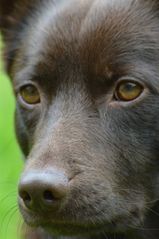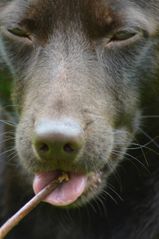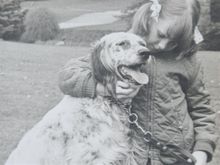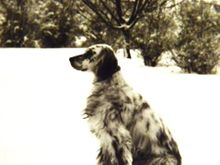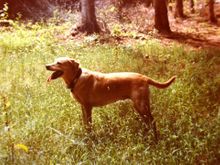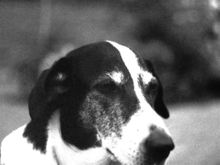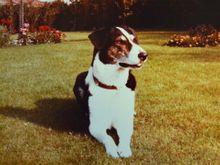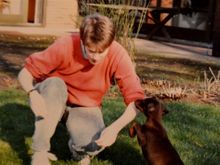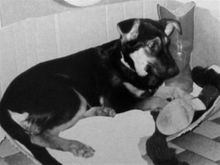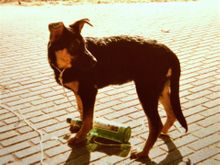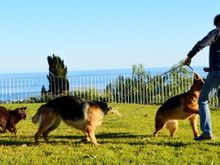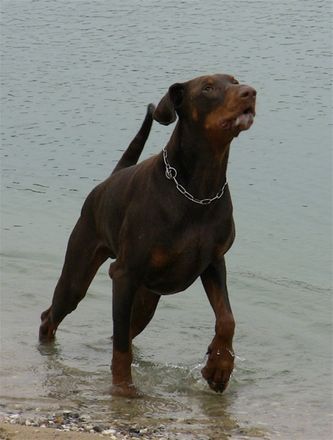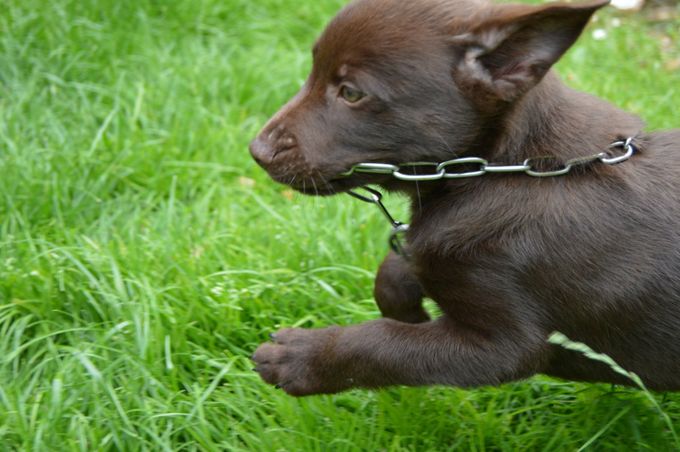Del siden
Introduction
The Kelpie Konnection, or abbreviated, thekk, is a small website primarily about my Australian Kelpie, Tarrawangas Baxi.
But I will also mention my five dobes that have been part of my life for 30 years and with whom I have trained IPO.
Baxi and I live in a small town in a wooded area of Denmark, with easy access to walks in the forests.
Since 2013, when I brought Baxi home with me, we have trained in the Danish Association for Civilian Dog Handlers (Danmarks civile Hundeførerforening), with approximately 12,000 members throughout Denmark.
We work in the regular obedience and working programme - a programme that seems to suit kelpies.
Scroll down to read about my dog history.
Indledning
The Kelpie Konnektion, eller forkortet, thekk, er en lille hjemmeside primært om min australske kelpie, Tarrawangas Baxi.
Jeg vil dog også fortælle om mine fem dobermann, som har været en del af mit liv i 30 år og som jeg har trænet IPO med.
Derudover tilbyder jeg en række tjenester, som du finder under mit fritids-CV.
Baxi og jeg bor i en lille by i et skovrigt område af Danmark, med god adgang til gåture i skovene.
Siden 2013, da jeg hentede Baxi hjem, har vi trænet i Danmarks civile Hundeførerforening, med ca. 12.000 medlemmer i hele Danmark.
Vi arbejder i DcH’s eget program med lydigheds- og frie discipliner – et program som passer godt til kelpien.
Min hundehistorie kan du læse mere om herunder (på engelsk).
The beginning
In 1966, when I was three, my parents took the whole family out to pick up our first dog. From what I understand, they decided to get a dog because we three children panicked when we saw a dog in the street. Back then there was only one way to cure a dog phobia and that was to get one. As our mother was Irish, she wanted an Irish setter, but since there were none available at the time, we got an English setter instead. But the Irishness was not forsaken – my mother named our puppy Biddy Mulligan – call name Biddy.
We came home one August day with Biddy, and for the next ten days we children lived in the furniture where Biddy couldn’t reach us. Ten days down and we were cured. Now Biddy was just another member of our family and stayed with us for 10 years.
Back then dog handling classes did not exist as they do today. There are classes everywhere 24/7, well almost. There was no one to tell my parents that consistency is the key to a good relationship with your dog, so Biddy lived her own life the way she more or less wanted to. An open door meant that it was time to roam for a few hours, food on the kitchen counter with no one to watch meant that she should please help herself, and alone in the house she had all the furniture to herself.
The last three years of her life, I was the one who cared for her. In the spring of 1977 she was put to rest due to a severe cancer.
Despite my dog phobia at the age of three, Biddy turned out to be a valued friend, and because of her I developed my interest in dogs. When I was only 10, I started borrowing books about dogs from the library. Most of the books were about individual breeds, but by the mid-70s, I was able to find a few books about temperament and training. From there my interest just grew.
At one point I got a book with most of the recognised breeds in Denmark. There was a handful of breeds I was completely taken by, several were gundogs and one was the dobermann. I knew that I would not get a gundog as I wasn’t really interested in hunting and I do think the two go together. I would never make my parents’ mistake of getting an English setter and not take it hunting. But I could work with a dobermann, and the breed just fascinated me in ways I couldn’t explain.
One day when I was 14, I was walking down the streets of the city I lived in when I saw a man walking two dobermanns. In that instant I knew for certain that I would have a dobermann one day. It took another six years to get there so while I was still at school, I started looking after the dogs of friends of the family. These included first and foremost a collie/lab mix, Nuser, whom I ended up taking in for the last two years of his life. He died suddenly one spring day in my second semester at college and I lost my best friend. But I also looked after a yellow lab, Polly, and a miniature dachshund, Jonas. And later I took in a puppy (told to be an Eastafrican German shepherd?), Baik, and had her for three months before she was shipped off to Kenya. She was such a charm and would have been fun to keep, but the day she left me, Nuser came in and stayed with me for the rest of his life.
Biddy and me in 1970
FROM 1970 ...
Biddy
Polly
Nuser
Polly was supposed to be here too in a photo with Nuser, but I must have mislaid it. So for now it is just Nuser. And you will find Polly below.
Nuser
Teis 8 weeks, playing with me in my parents' garden.
Baik - No matter how often we removed shoes from her bed, she got up and brought them back. She never left a bite mark - just cuddled up with them.
Baik - stealing a chance to lick some liquor. Have no idea how she came to like alcohol, but she did. And she liked tobacco too. Makes you think that the breeder might have had some bad habits.
Baxi playing with friends in Spain.
... TO 2017
The Dobermann
I was in my early years at college and still living at home when I kept thinking about getting my first own dog. Bringing a puppy into my parents’ house required a lot of molding so it took quite some time. My mother wasn’t worried about me wanting a dobermann as she didn’t know the breed as she said – I think she was more worried about the everyday nuisance of having a dog in the house. My father was worried about the breed so I asked him to come with me to a few dog shows and ‘by chance’ we ended up by the dobermann ring. On several occasions I noticed that there were more incidents between the dogs of other breeds while we never saw any between the dobermanns. After all the breed was not as bad as its reputation and in the end that did the trick.
Next step was to find a litter. I called the chair of the Danish Dobermann Club and the longer we talked about all the challenges of the breed, the more I wanted a dobe. And at the end of our long talk, he said to me, ‘if you still want a dobe, go ahead!’.
Three months later I had organised with my father to drive out to pick up my first dobermann. I had already seen the litter and I found out that it was not easy to pick the right dog. All the books back then said to go for an outgoing puppy. What do you do when the whole litter is outgoing and jumps right into your lap? I had no clue except I wanted a black and tan and ended up with a brown and tan. No regrets, I loved the colour and as you can see in my pictures, four of my five dobes were in fact brown.
I brought home Fetich in May and started at the new local dobe training club in August. In the meantime I spent time teaching Fetich various exercises, but in those days training methods were really not worth much. Way too much jerking and way too little praise. No play, only treats. This was not the best approach for any dog, least Fetich, who as he matured, suffered from hormonal issues. I did manage to earn an IPO1, but at this stage he was diagnosed with hypothyroidism and the side effects it had had on his whole system, such as feminisation syndrome. He was sadly put to sleep at the young age of 4 years and 10 months.
However, now I knew a lot more about the breed and what I wanted and how I wanted to train so when I went for my next dobe, I knew what I was looking for … and got it. You can read more about each dog under their own link.
My dobe life overall consisted of good as well as bad experiences. The curiosity and intelligence of the breed is fascinating; the hereditary diseases are horrendous, and there seems to be little interest in Europe to do anything about them. Four of my five dobes suffered from hypothyroidism. The excuse seems to be that some dobes just suffer from a poor coat quality. No, a healthy dog has a healthy coat! One dobe was put to sleep at the age of 14 months due to a possible brain tumour, and my last dobe suffered from sudden death of DCM. DCM is a rampant disease in the breed, but in Denmark even as late as in 2013 when Dako died, I had to hear people come up with all sorts of excuses for sudden death in the breed. People will even say that it’s only males who suffer from sudden death! I know of several females who’ve suffered from sudden death. Both American and European studies of DCM show that almost 60 per cent of the breed will at some point die of DCM. Now that’s a serious problem in the breed. From a consumer’s perspective, we pay full price for a dog who only lives half a life!
Health issues in the breed along with my own health issues put a stop to me working with dobermanns. A few years before Dako died, I started searching for a smaller breed. I had gone through a number of medium-sized breeds and kept getting back to the Australian Kelpie. One day when I saw a litter of kelpies on youtube, I thought that if this is what kelpie pups are like, this is the breed for me!
The Australian Kelpie
Baxi 9 weeks
The litter on youtube was sold so I wasn’t going to get any of these pups, but I contacted their breeder who lived less than an hour away. Could I possibly see her female? Yes, but it had to wait until the competition season was over. Kitty had qualified for the Danish Championship to take place in September 2011 and she would probably not have her next litter until autumn 2012 or spring 2013. Okay, that was a while to wait, but then I was still living in a flat where I could only have one dog, and I still had Dako.
In January 2013 I had a serious accident and tore my knee to shreds and the last thing on my mind was a puppy. I was at home recuperating when kennel Tarrawangas sent me an email with the news of expected puppies after Kitty – she was having puppies mid May that year. I had to decline and I hated it! Then I was finally able to remove my donjoy and drive again. I took out Dako for a short run and promised him that I would take him out for a better run the next morning, hoping the weather would be a bit better.
That was to be Dako’s last run. After having played ball with a big grin on his face for 20 minutes, he came over to me and dropped dead at my feet. Now I had no dog, had turned down a puppy and had a long period in front of me with rehabilitation. I talked to a friend and she suggested that I contact the breeder and see if she might still have a puppy for me. And she did. Now I had something to look forward to. The puppies were ready to leave Kitty in July.
After the pups were born and had turned three weeks old, I spent many a day visiting. How precious they were. I waited for 4 long weeks to finally find out that I would be getting my favourite, a small cuddly teddy bear of a kelpie pup, and I named him Baxi. As my 6-yr-old nephew said about Baxi and his brother Benji, ‘that one looks like a Baxi, the other one doesn’t’. Little was I to know that he would be right!
Since then I have never looked back. The kelpie suits me and I got one with the kind of zest that I like in dogs: creative, outgoing, friendly, fun-loving and willing to work for hours. And a much better size for me than the dobermann since I have had to slow down a lot after my accident.
Learn more about Baxi on the kelpie link. Click on 'My kelpie' to read Baxi's presentation, or the sublinks for specific information.
Del siden
